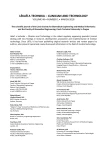Median method for determining cortical brain activity in a near infrared spectroscopy image
Autoři:
Ondřej Klempíř 1; Radim Krupička 1; Robert Jech 2
Působiště autorů:
Department of Biomedical Informatics, Faculty of Biomedical Engineering, Czech Technical University in Prague, Kladno, Czech Republic
1; Department of Neurology, First Medical Faculty and General University Hospital, Charles University, Prague, Czech Republic
2
Vyšlo v časopise:
Lékař a technika - Clinician and Technology No. 1, 2018, 48, 11-16
Kategorie:
Původní práce
Souhrn
Near-InfraRed-Spectroscopy (NIRS) is a neuroimaging method of brain cortical activity using low-energy optical radiation to detect local changes in (de)oxyhaemoglobin concentration. A methodology consisting of a raw signal pre-processing phase, followed by statistical analysis based on a general linear model, is currently being used to determine signal activity. The aim of this research is to define the median modification of the standard method usually used for the estimation of cortical activity from the NIRS signal and to verify its applicability in measuring motor tasks for patients with Parkinson's disease. Individual examinations were conducted in 10 cycles, during which finger tapping, and rest phases were alternating. Changes in oxyhaemoglobin concentration were calculated from the native NIRS signal using the modified Lambert-Beer equation. The signals were filtered in the 0.015–0.3 Hz band and fitted by the physiological response function of the brain tissue for each finger tapping cycle separately. The median value from the 10 cycles was then computed. Activity values obtained in individual subjects have been used in Brain Mapping visualizations. These describe motor task patterns during the ON and OFF deep brain stimulation of the subthalamic nucleus in Parkinson's disease, which demonstrates activation in accordance with the current state of knowledge in functional imaging.
Keywords:
near infrared spectroscopy, neuroimaging, Parkinson's disease, neurophotonics, brain mapping, neuromodulation
Zdroje
- Glover, H.: Overview of Functinal Magnetic Resonance Imaging. Clinical Neurosurgery, 2011, vol. 22, no. 2, p. 133–139.
- Agbangla, N. F., Audiffren, M., Albinet, C. T.: Use of near-infrared spectroscopy in the investigation of brain activation during cognitive aging: A systematic review of an emerging area of research. Aging research reviews, 2017, vol. 38, p. 52–66.
- Cui, X., Bray, S., Bryant, D. M., Glover, G. H., Reiss, A. L.: Quantitative comparison of NIRS and fMRI accros multiple tasks. Neuroimage, 2011, vol. 54, no. 4, p. 2808–2821.
- Tohka, J., Foerde, K., Aron, A. R., Tom, S. M., Toga, A. W., Poldrack, R. A.: Automatic independent component labeling for artifact removal in fMRI. Neuroimage, 2008, vol. 39, no. 3, p. 1227–45.
- McKendrick, R., Mehta, R., Ayaz, H., Scheldrup, M., Parasuraman, R.: Prefrontal Hemodynamics of Physical Activity and Environmental Complexity During Cognitive Work. Human factors, 2017, vol. 59, no. 1, p. 147–162.
- Oussaidene, K., Prieur, F., Tagougui, S., Abaidia, A., Matran, R., Mucci, P.: Aerobic fitness influences cerebral oxygenation response to maximal exercise in healthy subjects. Respiratory physiology & neurobiology, vol. 205, no. 1, p. 53–60.
- Bick, S., Folley, B., Mayer, J., Park, S., Charles, P. D., Camalier, C. R., Pallavaram, S., Konrad, P. E., Neimat, J. S.: Subthalamic Nucleus Deep Brain Stimulation Alters Prefrontal Correlates of Emotion Induction. Neuromodulation, 2016, vol. 20, no. 3, p. 233–237.
- Arizono, N., Ohmura, Y., Yano, S., Kondo, T.: Functional Con-nectivity Analysis of NIRS Data under Rubber Hand Illusion to Find a Biomarker of Sense of Ownership. Neural Plasticity, 2016, vol. 2016, p. 1–9.
- Tak, S., Ye, J. C.: Statistical analysis of fNIRS data: A compre-hensive review. Neuroimage, 2014, vol. 85, no. 1, p. 72–91.
- Statistical Parametric Mapping. www.fil.ion.ucl.ac.uk/spm/ [cit. 2. 12. 2017].
- Krajca, V., Petranek, S.: Wave-Finder: A new system for an automatic processing of long-term EEG recordings. Quantitative EEG analysis clinical utility and new methods, 1993, p. 103–106.
- Cope, D., Delpy, D. T.: System for long-term measurement of cerebral blood oxygenation. Medical Computing, 1988, vol. 26, no. 3, pp. 5.
- Boynton, G. M., Engel, A. S., Glover, G. H., Heeger, D. J.: Linear systems analysis of functional magnetic resonance imaging in human. Journal of Neuroscience, 1996, vol. 16, no. 13, p. 4207–4221.
- Electrode 10-20 positions, mapping, anatomical brain areas. http://www.brainm.com/software/pubs/dg/BA_10-20_ROI_
Talairach/nearesteeg.htm [cit. 3. 12. 2017]. - NFRI toolbox. http://www.jichi.ac.jp/brainlab/tools.html [cit. 3. 12. 2017].
- xTopo. http://www.alivelearn.net/?p=785 [cit. 3. 12. 2017].
- AFNI. https://afni.nimh.nih.gov [cit. 3. 12. 2017].
- Nitime. http://nipy.org/nitime/ [cit. 3. 12. 2017].
- NIfTI. https://nifti.nimh.nih.gov [cit. 3. 12. 2017].
- Nilearn. http://nilearn.github.io [cit. 3. 12. 2017].
- Payoux, P., Brefel-Courbon, Ch., Julian, A.: Motor activity in parkinsonism and levodopa effect: A PET study. Journal of nuclear medicine, 2007, vol. 48, no. supplement 2: 8P.
- Naoki, I., Takefumi, M., Akira, S., Eiji, K., Fumiko, I., Koji, T., Yasuki, K., Takayuki, T., Toshio, H.: Monitoring Local Regional Hemodynamic Signal Changes during Motor Execution and Motor Imagery Using Near-Infrared Spectroscopy. Frontiers in physiology, 2015, vol. 6.
- Hou, L. B., Bhatia, S., Carpentera, J. S.: Quantitative compari-sons on hand motor functional areas determined by resting state and task BOLD fMRI and anatomical MRI for pre-surgical planning of patients with brain tumors. Neuroimage: clinical, 2016, vol. 11, p. 378–387.
Štítky
BiomedicínaČlánek vyšel v časopise
Lékař a technika

2018 Číslo 1
Nejčtenější v tomto čísle
- Median method for determining cortical brain activity in a near infrared spectroscopy image
- A comparsion of the quality of dental crowns from TI-6AL-4V and cocr alloys made with SLM technology
- Dimensionality reduction methods for biomedical data
- Patient´s respiratory curve synchronization by visual feedback application
